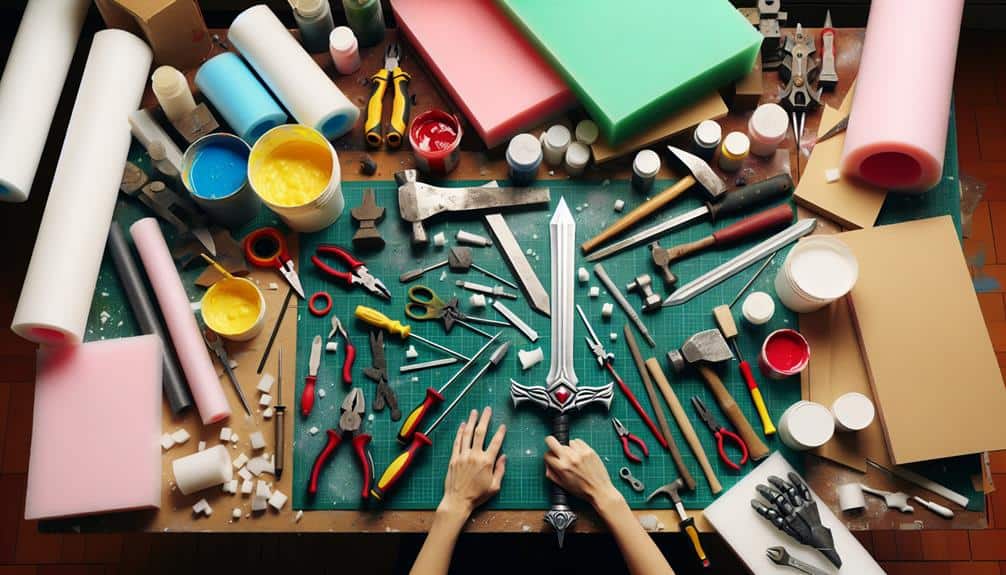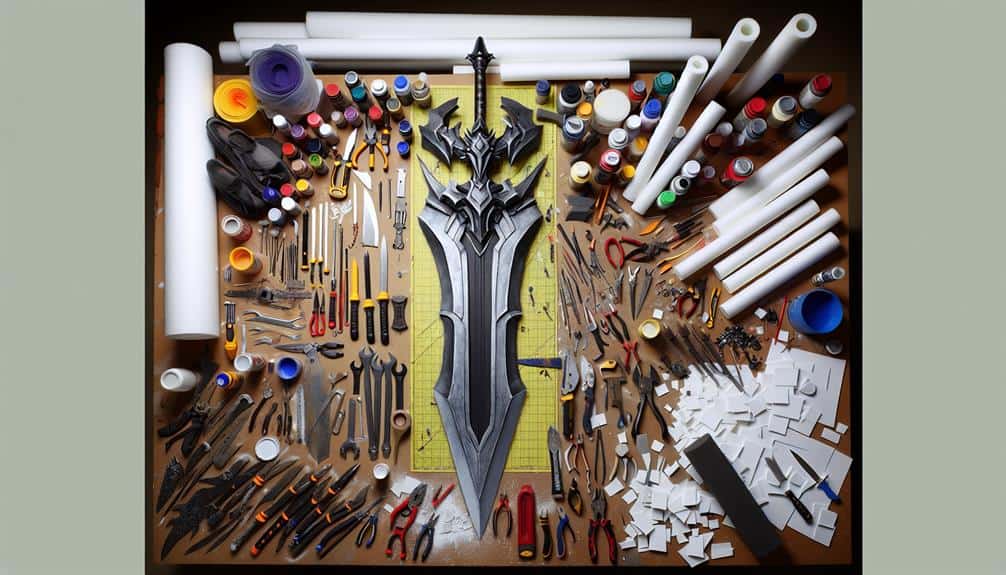Imagine you've decided to cosplay as your favorite character, but you can't find the perfect prop for your costume. You've seen amazing props crafted by others and wonder how they do it.
What if you could learn the secrets to creating stunning props that will take your cosplay to the next level? Discover the key steps and insider tips in prop-making that will set you up for success in bringing your favorite characters to life.
Key Takeaways
- Use essential tools like sandpaper and hot glue guns for prop-making efficiency.
- Master basic techniques such as foam carving and layering for depth.
- Elevate props with painting details like blending colors and weathering effects.
- Troubleshoot common issues like cracks and reinforcement for sturdy props.
Essential Tools for Prop-Making
To create breathtaking props for your cosplay endeavors, arm yourself with a versatile set of essential tools that will elevate your prop-making skills to new heights.
When it comes to sanding techniques, invest in sandpaper of varying grits to achieve smooth finishes on your props. Start with a rough grit to shape the prop and gradually move to finer grits for a polished look. For those finishing touches, having a sanding sponge handy can help you reach intricate areas with ease.
In prop-making, adhesive options are pivotal. Hot glue guns are fantastic for quick fixes and securing lightweight materials, while epoxy resin provides strong bonds for heavier components. Remember to choose the right adhesive based on your prop's materials to ensure durability.
After assembling your prop, sealing methods are essential for longevity. Consider using a clear sealant spray to protect your creation from wear and tear, especially if you plan to showcase it at multiple events. Mastering these techniques will undeniably level up your prop-making game.
Choosing the Right Materials
When crafting props for your cosplay projects, selecting the right materials is paramount to achieving authenticity and durability in your creations. To help you make the best choices, consider the following:
- Foam vs Resin: Foam is lightweight and easy to carve, making it great for intricate details, while resin offers a more solid finish and is ideal for creating sturdy props that can withstand wear and tear.
- Wood vs Plastic: Wood provides a natural look and can be easily shaped with tools, perfect for props requiring a rustic or historical aesthetic. On the other hand, plastic is versatile, durable, and often more cost-effective, making it a popular choice for a wide range of prop-making needs.
Basic Techniques and Tips
For crafting impressive props in cosplay, mastering basic techniques and tips is critical to elevate the quality of your creations. When working with foam carving, remember to start with a sharp utility knife or hot wire cutter for precise cuts. Create depth and texture by layering foam pieces and sanding edges for a polished finish. Experiment with different carving techniques like beveling or gouging to add intricate details to your prop.
To achieve realistic weathering effects, consider using techniques such as dry brushing with acrylic paints to create worn or aged looks. Utilize sponge or rag dabbing for rust or dirt effects, and don't be afraid to add splatter or streaks to mimic grime or weather damage. Remember to seal your weathering effects with a protective coat to guarantee longevity.
Painting and Detailing Props
Get ready to transform your props into stunning masterpieces through the art of painting and detailing. To achieve the best results, consider the following tips:
- Blending Colors: Experiment with different techniques like dry brushing or layering to achieve smooth shifts between colors and create depth in your props.
- Weathering Effects: Use techniques such as dry brushing with darker shades, sponging on rust or dirt effects, or even scratching the surface to give your props a weathered and realistic look.
- Detailing Precision: Pay attention to small details like adding textures, highlighting edges, and incorporating intricate designs to elevate the overall appearance of your props.
- Sealing and Protecting: Once your painting and detailing are complete, seal your props with a clear varnish or sealant to protect the finish and guarantee longevity.
Troubleshooting Common Prop-Making Issues
To troubleshoot common prop-making issues effectively, examine each step of your process with a critical eye and a problem-solving mindset. When fixing cracks or bubbles in your prop, consider using filler materials like epoxy putty or wood filler. Apply the filler generously, then sand it down once dry for a seamless finish. For ensuring smooth edges and seams, utilize sandpaper or a Dremel tool to carefully refine rough areas. Be patient and work in small sections to avoid over-sanding.
To prevent future cracks, reinforce your props with materials like worbla or fiberglass for added durability. Additionally, sealing your prop with a primer before painting can help create a smoother surface. If your prop requires intricate details, consider using sculpting tools or heat guns to mold and shape the desired features.
Frequently Asked Questions
How Can I Incorporate Electronics Into My Cosplay Props?
To add electronics to your cosplay props, consider using lighting effects for a dramatic flair and sound effects for extra authenticity. Incorporate remote control for convenience and interactive features for a dynamic experience that will enhance your overall look.
Are There Any Legal Considerations When Creating Cosplay Props Based on Copyrighted Characters?
When creating cosplay props based on copyrighted characters, be mindful of copyright infringement. Understand fair use guidelines to avoid legal issues. Get creative with your designs but always respect the original creators to stay in the clear.
What Are Some Creative Ways to Add Movement or Functionality to My Prop?
Craft your prop like a wizard imbuing a spell into a wand. Integrate motorized attachments for mesmerizing motion, hidden compartments for secret surprises, interactive features for engaging play, and sound effects for a truly immersive experience.
How Can I Effectively Transport and Store Large or Delicate Props?
When it comes to prop transportation and storage, consider investing in protective cases or custom foam inserts. Fragile prop handling is important, so wrap delicate parts in bubble wrap or soft cloth for added protection during transit.
Plunge into the virtual world of online forums and Facebook groups where prop-makers unite to exchange ideas and seek feedback. Explore local meetups at conventions to connect with fellow creators and fuel your prop-making journey.



